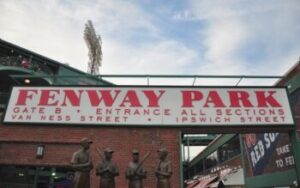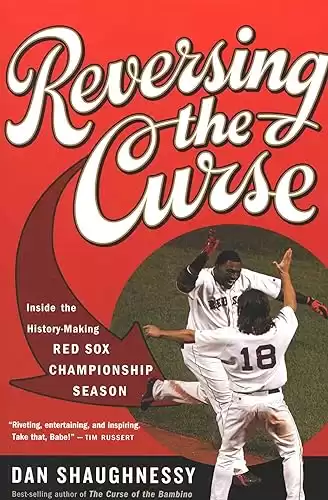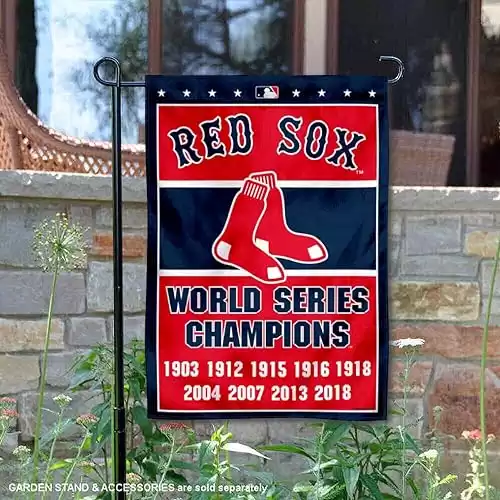For many Red Sox fans, it will feel like yesterday. But even for neutrals, it might feel a little strange to note that the Red Sox’ magical playoff run, the epic comeback against the Yankees in the ALCS, and the final reverse of the Curse of the Bambino was almost 20 years ago.
Fans still talk about it, of course. And Netflix is set to release a documentary on it this year. If you can’t wait for that, ESPN has covered the ALCS story with “Four Days in October,” one of the best editions of its 30 for 30 series.
***Please note. There are sponsored links in this post.***
So, what was the backdrop to ’04? And what happened to make it so special for the Red Sox? It’s not exactly an underdog story. The 2004 Red Sox roster was stacked with some of the best players in modern baseball – Pedro Martinez, Manny Ramirez, David Oritz, and Curt Schilling included. Indeed, the MLB lines for the 04 World Series preseason had the Red Sox’ odds at +400 – second favorite.
There were two problems, though. The hot favorite for the World Series was the Yankees, a team that had become more a nemesis than a rival to the Red Sox. Moreover, there was the curse of the Bambino.

The Curse in 2004
The Curse of the Bambino looms large in the annals of baseball history. Effectively, it comes from the Red Sox failure to win a World Series after trading Babe Ruth to the Yankees in 1920. Ruth was the key player for the Sox World Series-winning teams in 1915, 1916, and 1918, but a drought ensued thereafter. The Curse gained notoriety, not due to its length, but due to the perceived number of unlucky incidents that saw the Sox fail to win a World Series.
By 1990, the publishing of the book, The Curse of the Bambino by Dan Shaughnessy, rivaled the Chicago Cubs’ “Curse of the Billy Goat”. Yet, a key aspect was the rivalry with the Yankees. It probably does not need to be said that Ruth’s arrival in the Bronx kickstarted one of the most dominant eras in MLB history.
The Red Sox 2004 Regular Season
As mentioned, the Red Sox were not underdogs in 2004. One of the issues, however, was that the talented team seemed to be the architect of its own downfall again and again. In the 2003 ALCS, the Red Sox had come up against the Yankees, with the latter winning the series 4-3 in an all-time classic. The Red Sox blew a 4-0 lead in Game 7, fuelling the consensus of the Sox being not mentally equipped to deal with their rivals.
The 2004 season started fine; however, it went from 15 to 6 in April. They finished strongly, too, recording a 42-18 record from July through to October. They finished the 2004 season on 98-64, three games behind the Yankees. That was enough to secure the Wild Card spot (there was only 1 Wild Card per league back then) and send the Sox to the ALDS for a date with the Angels.
|
$2.99
|
$17.95
|
|
The 2004 ALDS
The 2004 ALDS feels like something of a forgotten series in light of what occurred afterward. The Sox dominated the then-Anaheim Angels (Los Angeles was added to the name a year later), winning the series 3-0 without really breaking a sweat. It sent Boston fans and the New England media into a frenzy. There was confidence, sure, but there was also the typical amount of self-doubt, especially given the Sox’ opponent in the ALCS, the hated New York Yankees.
The Bronx Bombers weren’t perfect in their own ALDS (3-1 vs. the Twins), but they oozed confidence as ever, and there was a sense of inevitability of overcoming their divisional rivals. All eyes were on Yankee Stadium and Game 1 of the ALCS on October 12th.
The ALCS and “Four Days in October”
We could write a book on everything that happened in the 2004 ALCS (indeed, several books have been written on the subject), so it’s tough to get everything in here. But let’s break it down as succinctly as we can.
The Yankees won the first three games of the series, two at Yankee Stadium and one at Fenway Park. The latter was the most bitter, with the Yankees hitting 19 runs in Boston’s home stadium. No team in MLB history had ever overcome a 3-0 series deficit. It was over, or so the newspapers and pundits claimed. There was a bit of a blame game in the media, too, with sniping from Boston Globe writers and rebuttals from players. The Red Sox were down and out.
Game 4 is etched on the minds of the most ardent Red Sox fans. Derek Lowe took to the mound for the Sox. Lowe gave up four runs over six innings, with the Sox trailing 4-3 in the bottom of the 9th. The great Mariano Rivera entered the game in the 8th to attempt yet another save for the Yankees. Kevin Millar hit a single to give the Red Sox the slimmest of hopes.
Dave Roberts came in as a pinch runner for Millar, eventually stealing second in the most dramatic of fashion. Bill Mueller managed to single off Rivera, allowing the lightning-quick Roberts to score. The game was tied 4-4 and going to extra innings. A nervy few innings passed before David Ortiz homered in the 12th, walking off for a 6-4 victory. The Red Sox had hope.

Game 5 was just as dramatic. Pedro Martinez pitched for the Red Sox, and things were going well as Boston took an early 2-0 lead. The Yankees scored three in the 6th inning, however, taking a 4-2 lead into the 8th. The Yankees once again blew the lead, with David Ortiz homering.
As with Game 4, extra innings would be needed to decide a 4-4 tie. Ortiz again had the decisive blow, singling in the bottom of the 14thinning to score Jonny Damon and bring the series to 3-2. Could the miracle happen? We would find out as the series returned to New York.
Game 6 was the game of the “bloody sock.” Curt Schilling, the Sox’ ace pitcher, had a severe tendon injury but was deemed healthy enough to pitch. As the game wore on, you could see the blood seeping into the sock of Schilling’s injured foot. Schilling was immense, however, shutting the Yankees out over six innings as Boston took a 4-0 lead.
The game was notable for the blood sock, of course, but also the near-riot among the Yankees fans. The rivalry had turned bitter. The Sox etched out a 4-2 victory, tying the series at 3-3. The city of Boston was in delirium.
Game 7 had none of the drama of the previous three. The Sox were 8-1 up by the 4th inning. The Yankees looked broken, a team in disbelief, unable to express what had happened. The game finished 10-3, meaning the Red Sox had done the impossible and overcome a 3-0 series deficit. The fact it had come against their bitter rivals made it all the more incredible. Now St Lous would await in the World Series, and there was a chance to reverse the curse.
2004 World Series
It’s ironic that the series that finally reversed the curse is remembered less than the ALCS before it. Arguably, it is because there was little drama in the 2004 World Series. The Sox swept the St Louis Cardinals 4-0. It was a dominant performance. The Sox led after the 1stinning in each of the four games and were never behind in any of them.
Did it feel like a comedown after the drama of the ALCS? Perhaps. Yet, the lack of drama was welcomed by Sox fans. They had gotten the monkey off their back against the Yankees, and the confidence for the World Series came because of that. The Cardinals were a decent team, but the Red Sox had juggernaut status at the point where they met. Nothing is inevitable in sports, but this felt fairly close.
Conclusion: One of the Greatest Stories in Sports History
Not everyone likes the Red Sox, but before 2004, it was hard not to sympathize with them. Call it a curse, bad luck, or whatever you want, but there was a sense of misfortune haunting the team, which was always in the shadow of its rivals from New York. Most of the ‘miracles’ focused on the ALCS, of course, and it’s hard to get away from the drama of that series.
Go back and look at the few minutes of Dave Roberts trying to steal second in the bottom of the 9th in Game 4 – it might be the tensest moment in sports history. But the story of the 2004 season started back in April, or perhaps all the way back in 1918. A story of countless failures and then a final, sweet redemption.


